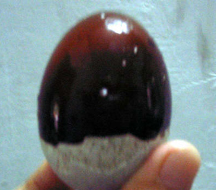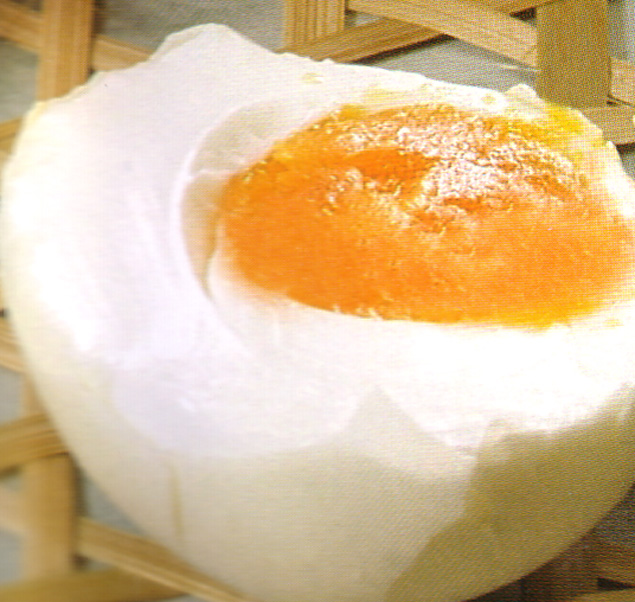
| What is Flavor and Fortune? |
| How do I subscribe? |
| How do I get past issues? |
| How do I advertise? |
| How do I contact the editor? |
Read 13356850 times
Connect me to:
| Home |
| Articles |
| Book reviews |
| Letters to the Editor |
| Newmans News and Notes |
| Recipes |
| Restaurant reviews |
| Article Index (all years, slow) |
| List of Article Years |
| Article Index (2026) |
| Article Index (last 2 years) |
| Things others say |
| Related Links |
| Log In... |
| Authors |
| Categories & Topics |
Preserving Duck Eggs with Lime or Brine
| by Irving Beilin Chang |
Eggs
Summer Volume: 2009 Issue: 16(2) page(s): 16 and 17
Preserved duck eggs are a Chinese speciality; the editor tells me there are many queries about them. They and fresh eggs were written about in Volume 11(4) on pages 27, 29, 30, and 32. Before that, I myself wrote an article titled: Duck Boys, Duck Eggs, and Egg Chemists in Volume 9(1) on pages 9 and 10. After both of these, the editor wrote another one about duck eggs and their preservation in Volume 15(4) on pages 28, 29, and 30. Yet, still the questions keep coming. We both mentioned their preservation, but provided few recipes that use them. The article in Volume 11(4) did discuss another egg preservation technique layering them with salt and wine residue. Many Chinese say those made this way are the best, especially those made in the Zhejiang Province. Many want to know how to use the duck eggs buried with lime and mud, and those salt-cured. This article may clarify many of their queries.
In the Chinese Duck industry, raising these birds means a surplus of duck eggs. Though loved, they are not as popular as chicken eggs when fresh. Thus, there was and still is a surplus of fresh duck eggs. How to market and use them has often been a problem. Many years ago before refrigeration, clearly, duck farmers needed ways to keep their eggs from spoiling. In earlier issues of Flavor and Fortune, coating them with lime/mud and putting them into a brine solution were discussed.
These preservation techniques kept the duck eggs for weeks, even months; untreated, they would have spoiled. Under the porous shell of every egg is a membrane that blocks pathogenic micro-organisms from passing through to the egg itself, but how long can that membrane and these curing methods keep duck eggs from spoiling? The salt-cured ones in a saturated brine solution do not spoil for some thirty days; the lime cured ones do not spoil for months.
 Those in lime and mud are usually buried for about one hundred days, and in Chinese, these are called pidan. The Chinese know to remove the lime/mud outer coating, then peel them revealing the bouncy brownish-black egg white, technically called the albumin. They know the yolk is dark green/greenish-yellow and more firm than creamy. They love them, most often eat them raw, but do cook them sometimes. They are usually quartered and served with soy sauce and pickled young ginger. When cooking them, they can be cut into smaller pieces and added to congee, mixed into an omelet made with chicken or duck eggs, or mixed with pork and either duck or chicken eggs and cooked as a pancake. These pidan eggs do not spoil if kept for six months at room temperature, or twice that long when refrigerated in shells without a single crack.
Those in lime and mud are usually buried for about one hundred days, and in Chinese, these are called pidan. The Chinese know to remove the lime/mud outer coating, then peel them revealing the bouncy brownish-black egg white, technically called the albumin. They know the yolk is dark green/greenish-yellow and more firm than creamy. They love them, most often eat them raw, but do cook them sometimes. They are usually quartered and served with soy sauce and pickled young ginger. When cooking them, they can be cut into smaller pieces and added to congee, mixed into an omelet made with chicken or duck eggs, or mixed with pork and either duck or chicken eggs and cooked as a pancake. These pidan eggs do not spoil if kept for six months at room temperature, or twice that long when refrigerated in shells without a single crack.
 In the case of xian dan or the salt cured duck eggs, they must never be eaten without cooking them. The salt coating or brining acts differently than the coating with lime. The white or albumin remains liquid, and tastes very salty because salt passes through the shell and the membrane, by a process known as osmosis. The yolk does not pick up as much salt as the white because of its high fat content. That is more true in chicken egg yolks. The yolks do gelatinize somewhat, and folks may refer to these thickened yolks as looking like partially dried apricots.
In the case of xian dan or the salt cured duck eggs, they must never be eaten without cooking them. The salt coating or brining acts differently than the coating with lime. The white or albumin remains liquid, and tastes very salty because salt passes through the shell and the membrane, by a process known as osmosis. The yolk does not pick up as much salt as the white because of its high fat content. That is more true in chicken egg yolks. The yolks do gelatinize somewhat, and folks may refer to these thickened yolks as looking like partially dried apricots.
The salt-cured eggs can be cooked as is, or used in baking. One common way is as part of the filling for cakes such as in moon cakes. Xian dan cured eggs can be stored in the refrigerator for a up to five or six weeks after the curing process is completed. Should you want to make your own, check out Volume 15(4), its page 29 has a recipe to do so.
Recently, most cured duck eggs are imported from Taiwan and packaged in groups of four. They come in foam, plastic, or corrugated containers, their mud coatings have been removed. Their porous shells are sprayed with oil to seal them. Salt-cured eggs can be found in plastic containers or in glass jars. After purchasing, store them in a reasonably cool place, or better yet, in the refrigerator.
With interest in ways to use these duck eggs, here are three recipes for pidan eggs popular in different parts of China. In the United States, some might call them salads as they are eaten cold or at room temperature. There are other Chinese salad-type foods on page 10 of this very issue.
In addition, I have provided two recipes using salt cured eggs; one in combination with pidan and tomatoes, the other steamed with pork. All these recipes are nutritious and tasty. Every one of them can be prepared quickly and easily. Every one of them was developed by my late wife, Wonona W. Chang. Do enjoy them all!
Note: When using the mud-coated duck eggs called pidan, crack and remove the mud coating, if not already done. Next crack and remove the shell, and rinse the egg in water until all coating is washed away. After this preparation, these eggs are ready to use.
| Pidan, Shanghai Style |
|---|
2 pidan 1/2 teaspoon sugar 2 Tablespoons thin soy sauce Preparation: 1. Wash and remove the shell, as instructed above. Then transfer the pidan into a shallow dish or bowl, and cut it into six or eight pieces. 2. Pour the soy sauce over the pidan and sprinkle sugar over them. Note: This dish can be served cold as is or it can be served with hot congee or steamed rice. |
| Pidan Salad, Cantonese Style |
|---|
3 or 4 pidan 3 slices fresh ginger, minced 2 Tablespoons cider vinegar 1 Tablespoon thin soy sauce Preparation: 1. Rinse and remove the shell from every pidan as instructed above. 2. Cut each pidan into six pieces and arrange them in the center of a serving dish. 3. Mix vinegar, ginger and soy sauce and pour it over the pidan, and serve them cold or at room temperature. |
| Pidan Doufu Salad, Northern Style |
|---|
3 or 4 pidan 1 pound square silken bean curd 1 Tablespoon thin soy sauce 1 teaspoon sesame oil dash of MSG (optional) Preparation: 1. Rinse and remove the shell from every pidan as instructed above, then cut each one into six or eight pieces. 2. Drain the liquid from the bean curd using a wire strainer, then dice it into half-inch cubes. Rinse the bean curd in cold water, drain well, and place it in a shallow dish with the pidan before adding the soy sauce, sesame oil and MSG, if using it. Mix gently and well. Note: For this recipe, we like to use the Vitasoy brand of silken tofu in a nineteen ounce container. We find others do not work as well. |
| Stir-fried Pidan and Xian Dan |
|---|
1 cup peanut oil 1/2 teaspoon granulated sugar 3 pidan 1 xian dan or salted duck egg 3 Tablespoons flour 2 teaspoons wine vinegar 2 fresh tomatoes, sliced Preparation: 1. Rinse the pidan but do not remove the shells. Cover them with cold water, and bring to a boil. Reduce heat and simmer for three minutes, remove them from the water, and then remove the shells. Quarter them. 2. Crack the uncooked salted egg into a bowl. Using a fork, break up the yolk and beat the egg until fluffy. 3. Gradually mix in the flour and vinegar with the salted egg and beat until smooth. Then mix the pidan with this mixture. 4. Heat wok, add the oil and deep-fry drained coated egg pieces until golden brown. Place them in the center of the plate and garnish with tomato slices around the outside of the plate. Serve hot or cold. |
| Steamed Pork Patty with Salt-cured Duck Egg |
|---|
1/2 pound ground pork 1/2 teaspoon sugar 1/2 teaspoon fresh chopped ginger 1 teaspoon cornstarch 1 Tablespoon soy sauce 1 teaspoon cooking sherry 1 salt cured xiandan duck egg 1 teaspoon vegetable oil Preparation: 1. Combine pork, sugar, ginger, cornstarch, soy sauce, and the sherry. Mix these ingredients together and form them into a ball. 2. Break the salt-cured egg in a bowl and beat it until well mixed. 3. Using the vegetable oil, coat a pie plate. 4. Roll the meat patty in the egg, then put it into the oil-greased pie plate, and press the patty flat. Pour any excess beaten egg over it. 5. Steam all ingredients over rapidly boiling water for thirty minutes. Serve hot. |

Copyright © 1994-2026 by ISACC, all rights reserved
Address
3 Jefferson Ferry Drive
S. Setauket NY 11720